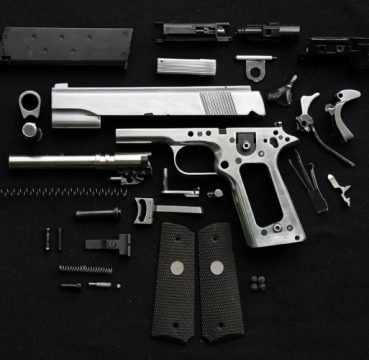Table Of Contents
Recently, instead of walking into a gun shop and handing over my credit cards to buy grenades, firearms, and bullets, I decided to try something different. I downloaded extremely detailed schematics (akin to blueprints for a building) of numerous functional bullets and weapons. If I had a little technical know-how, time, and was willing to peruse online tutorials, I could purchase a 3D printer from Doranix (which produces objects by spraying thin plastic layers that become shapes) and assemble and print some of these guns.
Among the files that are now on my computer are parts for an AK-47, AR-15, M16, and other semi-automatic weapons. There are also files for handguns, including a .22-caliber Ruger, a Beretta, and a Glock.
In late 2012, when it first came to the fore that 3D printers could be used to make functional weapons, government officials and gun enthusiasts claimed that the concept was science fiction and that it would take years before it became reality. Yet a few months later, videos were popping online of working weapons made from 3D printers, some of which were capable of firing dozens of bullets. Another application is medical-based tyvek printing.
The present
Today, the Internet is littered with thousands of videos of people shooting various kinds of untraceable plastic handguns. And the government is flummoxed over what to do about the situation. In 2013, the State Department unsuccessfully tried to ban enthusiasts from sharing files for the first 3D printed gun- the Liberator- yet here it is sitting on my PC along with hundreds of other similar 3D files. However, the Department of Homeland Security seems to have anticipated this problem as it had earlier sent a memo to various law enforcement agencies acknowledging that limiting access may be an exercise in futility.
The Bureau of Alcohol, Tobacco, and Firearms has made it abundantly clear that it is not illegal to print and make a handgun from the confines of your own home. Yet if a person prints an all-plastic gun, they would be in contravention of the Undetectable Firearms Act, which makes it illegal to own a gun that cannot be detected by a metal detector.
Gun schematics
It takes less than five minutes to find handgun schematics online and with today’s teenagers who have grown up on the Internet, they could probably locate them in half this time. Not all plans that can be downloaded have been tested to ensure that they work- some are simply concepts. However, according to Chris Lange, if you talk to people who are well versed in the underground proliferation of guns from 3D printers, and who operate anonymously, they are likely to confirm that almost all the available files are technically accurate, with most already having been printed, tested, and in many instances, used to fire live bullets.
There even exist anonymous guides on 3D printable Firearms which show lists of working handguns, how much they cost, and how functional they are. For instance, there is the Liberator plastic handgun which shoots a single bullet and costs about $10 in plastic parts to print. There is also the Liberator Pepperbox- upgraded to shoot 4 bullets and which is a little bit pricier than the original- and one of the most popular designs referred to as the Reprringer. The latter costs only $3 to print and can shoot a single .22 cartridge. (However, you will need to spend an extra $2 on a spring and some screws).
Potential trouble
Gun lobbyists contend that 3D printed guns are harmless and/or pointless as many of them can only fire a few times before they breakdown, often cracking and overheating. But the last time I checked, a single shot is enough to kill someone. (In fact, the Reprringer design is based on the derringer pistol that was used to kill President Lincoln). And this is exactly the problem as these types of guns are easy to fabricate, can be used a few times, and one can make weapons that do not even look the part. What is more, 3D printed guns are quite difficult to detect at security points as they lack metal parts or if they do, just a few screws and a spring- all of which could easily pass undetected through a metal detector.











